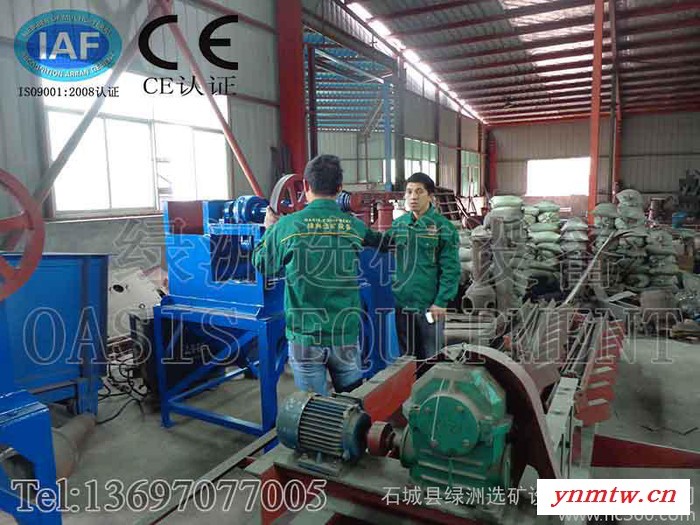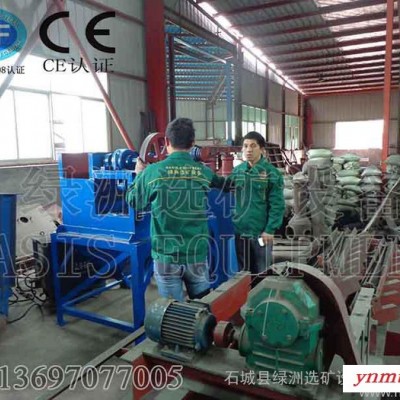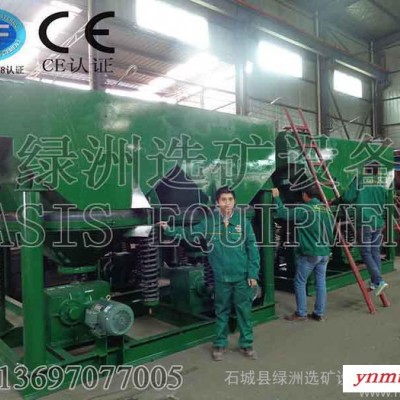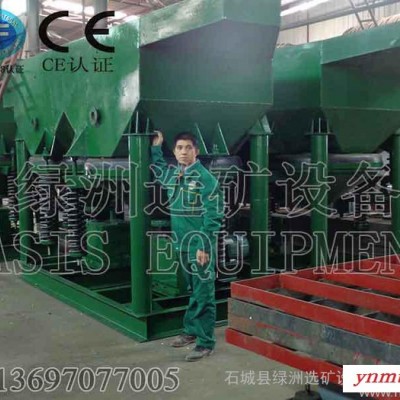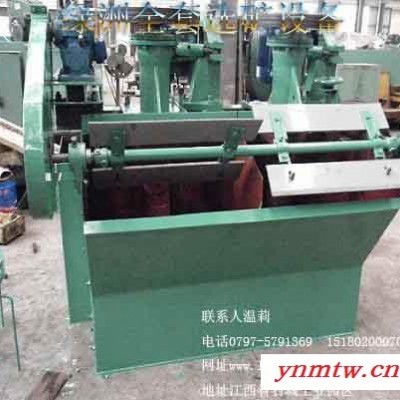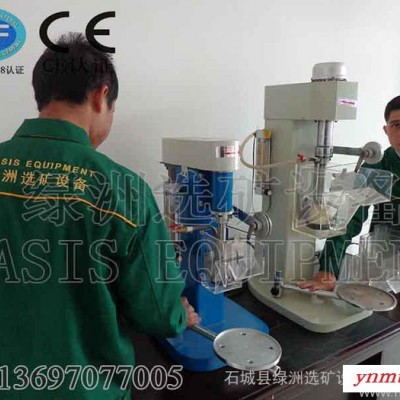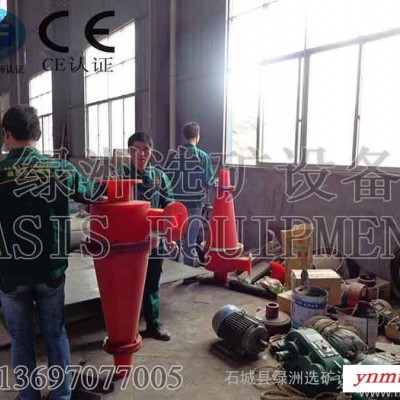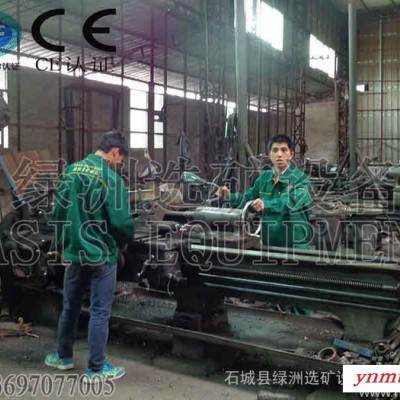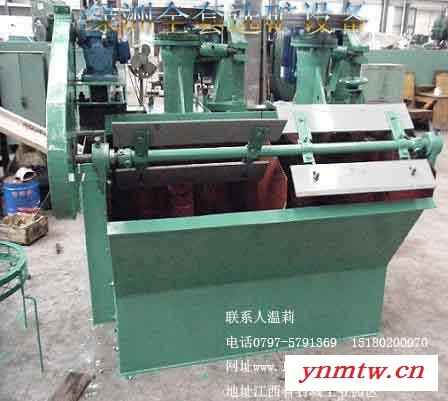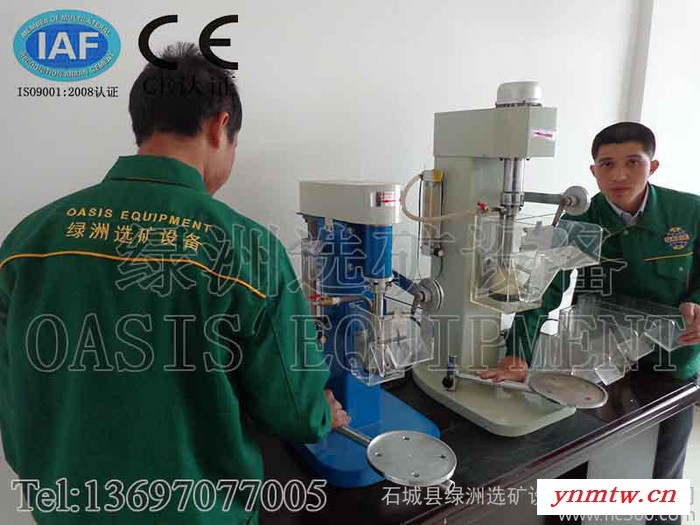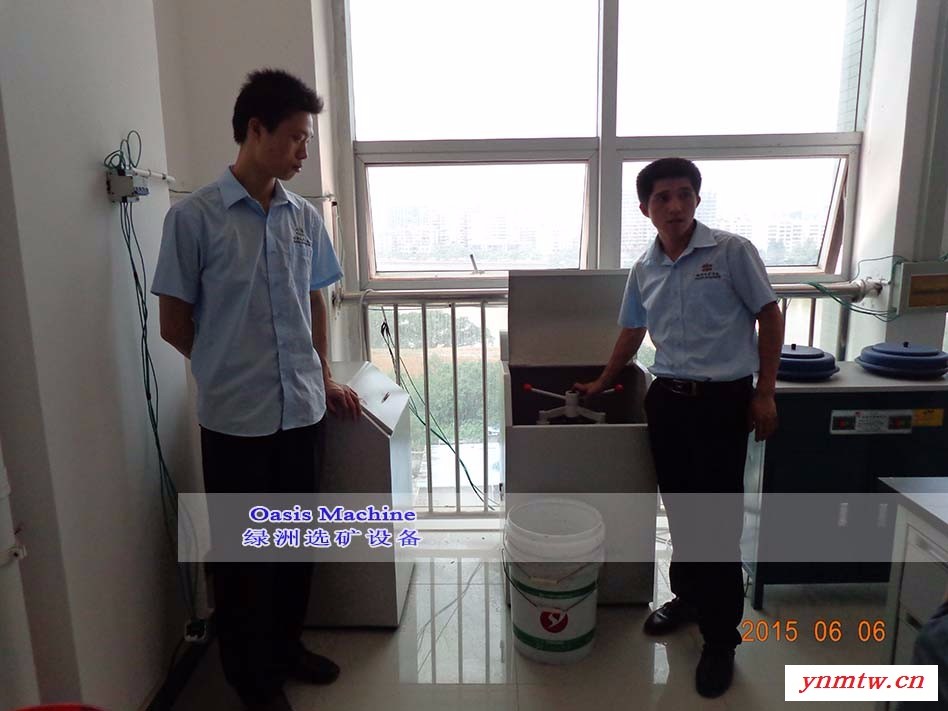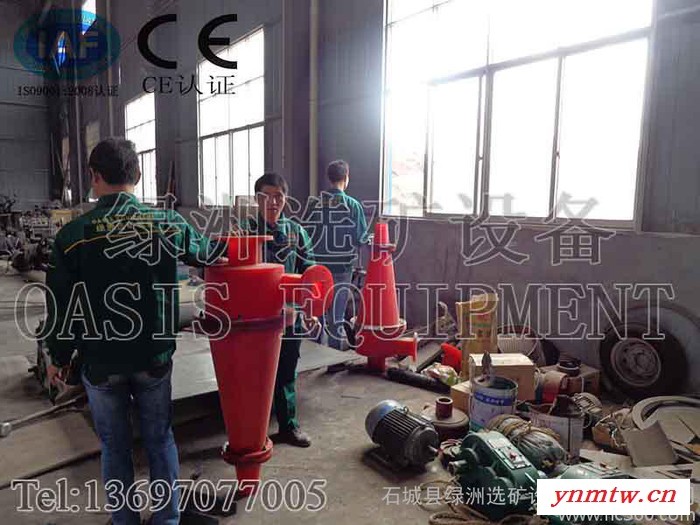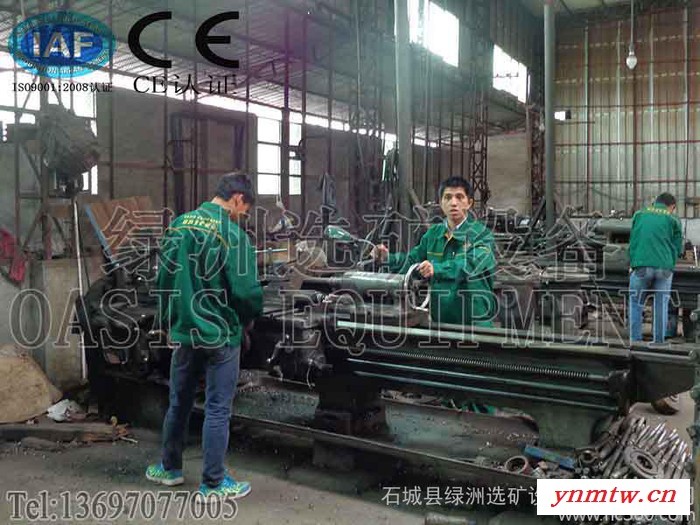| 别名 | 跳汰机 |
|---|---|
| 产品别名 | 重选设备 |
| 出料粒度 | 2.4 |
| 电动机功率 | 7.5 |
| 电动机转速 | 1000 |
| 规格 | LZJT |
| 生产能力 | 10-20 |
| 输出功率 | 1 |
| 外形尺寸 | 1630/1310/2010 |
| 用途 | 矿山,冶金 |
| 重量 | 0.9 |
| 最大进料粒度 | <10 |
| 给料口尺寸 | 60 |
| 品牌 | 绿洲选矿设备 |
| 型号 | 5-2 |
| 加工定制 | 是 |
公司专业制造实验室及生产用选矿设备13970115002www.lzkysb.cn温会燕0797-5745599生产跳汰机,动筛跳汰机,锯齿波跳汰机,圆锥跳汰机,锯齿波梯形跳汰机,锯齿波矩形跳汰机,锰矿跳汰机,隔膜跳汰机,跳汰设备,XCT跳汰机, 重力设备,水力选矿设备,跳汰设备,跳汰机设备 公司生产的跳汰机,单斗跳汰机,隔膜跳汰机,双斗跳汰机,锯齿波矩形跳汰机,锯齿波梯形跳汰机,左式和右式跳汰机有JT,LTS等各种系列,该机是固定筛子式,适用于选别金属矿石,如钨,含金的砂矿,精选锡矿等,也可用于选细粒物料和粗粒物料,最大给矿粒度为30毫米.采用筛上筛下排矿选别粒度范围广.
公司多次获得优秀企业奖和重合同守信用企业,售后服务先进单位,是石城县的重点企业,冶金行业选矿机械的骨干企业,我公司与全国各科研单位进行密切交流合作.对产品创新换代,推出一系列高效节能环保产品,优惠的产品价格,竭诚周到一如既往的与各界朋友建立友谊并接受来图来样,非机械设计制造等方面的真诚合作,随时欢迎前来参观指导!
JT、 跳汰机Gravity Jig
跳汰机选矿是重力选矿的主要方法之一,工艺特点是:被选的矿石连续给到跳汰室的筛板上,形成厚的物料层。通过筛板周期地鼓入上升水流,使床层升起松散,接着水流下降(或停止上升)。在这一过程中,密度不同的颗粒发生相对转移,重矿物进入下层,轻矿物转入上层,分别排出后即得精矿和尾矿。本产品由原地矿部唯一指定企业生产,执行行业标准。
锯齿波跳汰机区别在于:跳汰脉动曲线为锯齿波形,上升水流快而下降水流慢,床层被整体抬起又缓慢下落,有效松散时间长,可大幅度地提高单位筛面的处理能力,降低粒度回收下限,并大量节省筛下补加水。与正弦波跳汰机进行工业试验对比,踞齿波跳汰机回收率提高Sn:3.01%, WO3:5.5%, Pb:1.63%, Zn:2.04%,耗水量减小30-75%。
锯齿波跳汰选矿,除了很微细的物料外,几乎可以处理各种粒度的矿物原料。工艺操作简单,设备处理能力大,并可在一次选别中得到某种最终产品,因此,在生产中应用很广泛。对于金属矿石,是处理粗、中、细粒铁矿锰矿的主要方法之一,并大量用于选别锡、钨矿石;跳汰法在处理含金,钽铌、钛、锆、铬的原生矿石和砂石的选别亦能获得良好效果。
矿石中待分离的矿物密度差越大,入选料度范围越宽,对于含金砂矿,在给料粒度小于25 mm时,可以不分级入选,回收下限可达0.05 mm,对一般金属矿石,实行分级入选,可有效地改善分选指标并提高设备的处理能力。
Ore dressing by Gravity Jig is considered as one of the major means for gravity beneficiation with the process characteristics being continued feed of ores to be beneficiated onto screen plate in Jigging Chamber, forming thick material layer. Upward flow is injected via screen plate periodically, allowing the lift of bed layer to be loose and flow to drop(or stop rising ).During this process, grains of different densities will displace relatively, with the heavy materials bring delivered into lower layer and the light material being transferred into the upper layer. Concentrate and tailings will be obtained after their being discharged respectively.
Sawtooth-wave Jig is a new type of energy conservation and highly efficient gravity separation equipment and developed based on the traditional Sine Wave Jig. The difference between Sawtooth .Wave Jig and Sine Wave Jig is that the pulsation curve for jigging is of sawtooth wave shape, with speedy upward flow and slow downward flow. Bed layer is elevated integrally and slowly dropped with a long effective loose time, allowing significant increase of handling capacity for unit serene surface, decrease of lower limit of grain size recovery and large save of make-up water for undersize fraction. Industrial tests carried out of Sawtooth Wave Jig and Sine Wave Jig for comparison showed that the recovery rate for operation of Sawtooth Wave Jig is raised by Sn:3.01%,Pb:1.63%,Xn:2.04% with water consumption being decreased by 30-75%.
Ore dressing by Sawtooth Wave Jig is capable of handling almost full sizes of mineral materials other than very fine material. It features simple process operation, heavy duty equipment handling capacity with final products being obtained through one time separation. Therefore, it has found a wide application in production. It is regarded as one of major means to cope with metallic ores such as iron and manganese ores of coarse, moderate and fine sizes and has found significant use in beneficiating tin and tungsten ores. Moreover, Jigging Method also can achieve a good result in processing primary ores bearing gold, tantalum niobium, titanium, zirconium and chrome and sand stones.
More density minerals to be separated in ores have, wider range the feed sizes have. For gold bearing placer, when feed grain size is less than 25 mm, separation may be carried out without size classification with the lower limit of recovery up to 0.05 mm. For ordinary metallic ores, size classified separation is conducted to effectively improve indexes for separation and to enhance handling capability for the equipment.
型号规格 Model | 总面积 Area | 冲程 Stroke | 冲次 Times of stroke | 给料 粒度 Feed Size | 处理 能力 Capacity | 给水量 | 功率 Power | 外形Overall dimensions | 质量 Weight |
㎡ | mm | r/min | mm | t/h | m3/h
| kw | mm | t | |
JT2-2 | 2.28 | 12-17 | 80-180 | <10 | 4-8 | 1-3 | 2 | 3220/1550/2050 | 1.6 |
JT3-1 | 3.3 |
| 80-120 | <10 | 6-10 | 1-3 | 5.5 | 3180/2000/3030 | 3.26 |
JT4-2 | 4.33 | 6.5-25 | 80-120 | <30 | 10-15 | 1-2 | 7.5 | 3600/1850/2600 | 4.6 |
JT5-2 | 4.86 | 15-25 | 80-120 | <10 | 10-20 | 1-2 | 7.5 | 3600/2000/2600 | 4.8 |
DYTA7750-3 | 9.9 | 20-30 | 0-90 | <25 | 50-75 | 2-5 | 5.5 | 7750/3060/2700 | 6 |
DYTA7750-4 | 13.2 | 20-30 | 0-90 | <25 | 66-100 | 2-5 | 7.5 | 7750/3060/2700 | 7.5 |
DYTA7750-6 | 19.8 | 20-30 | 0-90 | <25 | 100-150 | 2-5 | 7.5 | 7750/3060/2700 | 12.5 |
DYTA7750-8 | 26.4 | 20-30 | 0-90 | <25 | 132-197 | 2-5 | 11 | 7750/3060/2700 | 16 |
DYTA7750-9 | 29.7 | 20-30 | 0-90 | <25 | 150-220 | 2-5 | 11 | 7750/3060/2700 | 17.5 |
DYTA7750-12 | 39.6 | 20-30 | 0-90 | <25 | 220-300 | 2-5 | 15 | 7750/3060/2700 | 21 |
300/450隔膜 | 2.7 | 0-26 | 320 | 12 | 3-6 | 2-3 | 1.1 | 1230/1270/1750 | 0.74 |
370/360隔膜 | 2.75 | 5-25 | 2-5 | 6 | 1-3 | 2-3 | 1.1 | 1000/600/1600 | 0.24 |





